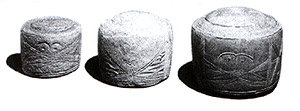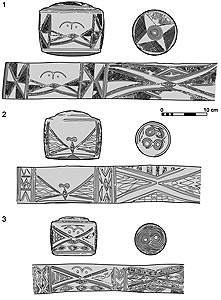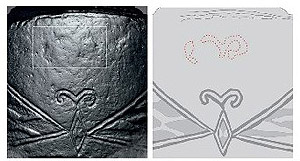Neolithic Yorkshire – The Folkton Drums

Folkton Drums (Late Neolithic/Early Bronze Age c. 2500 BC)
The Folkton ‘Drums’ constitute three of the most remarkable decorated objects from Neolithic Britain. Mystery has surrounded these three enigmatic stone cylinders since they were excavated in the late 19th Century by Greenwell from a barrow associated with a child’s burial but with no datable grave goods, in Folkton, near Filey in East Yorkshire. Known as the Folkton Drums, they range in size from 146mm in diameter through 124 mm diameter down to the smallest at 104mm in diameter. The drums are unique in the archaeological record – nothing similar is known anywhere in the British Isles from any time in the prehistoric periods. They are now on display in the British Museum.
Each of the drums bears a unique incised design, covering the sides and domed tops. essentially geometric decoration is organised in panels with stylised human faces looking out from two of the drums

Folkton Drums: image by Aaron Watson (redrawn from an original by Longworth) (Late Neolithic/Early Bronze Age c. 2500 BC)
The tops bear concentric circle decoration. The whole design is reminiscent of Passage Grave motifs, but the strongest resemblance is to the Grooved Ware ceramic style from the Late Neolithic period, with suggestions of Beaker-style decoration from the early Bronze Age, c. 2500-2000BC.
New analysis using Reflectance Transformation Imaging and photogrammetry has revealed evidence for previously unrecorded motifs, erasure and reworking.
Hence these chalk drums were not decorated according to a single, pre-ordained scheme, but were successively carved and re-carved over time. Such practices may have been widespread in the making of artefacts in Neolithic Britain. The study of these drums also demonstrates the ability of these new techniques not only to record visible motifs, but to document erased and reworked motifs clearly.
Doubts have been expressed over the material of the drums, with claims that they are made either from local chalk or from magnesian limestone from a source up to 45 miles away. Now examination by a team of experts has finally resolved the argument. Light and electron microscopic examination has revealed microfossils typical of the late Cretaceous (e.g. coccoliths), confirming chalk. The drums therefore were clearly manufactured from a local supply. The problem of their precise cultural significance, however, remains unresolved.

Folkton Drum 2: partially erased eyebrow motif (highlighted in the white rectangle) directly above the double spiral motif (RTI image)